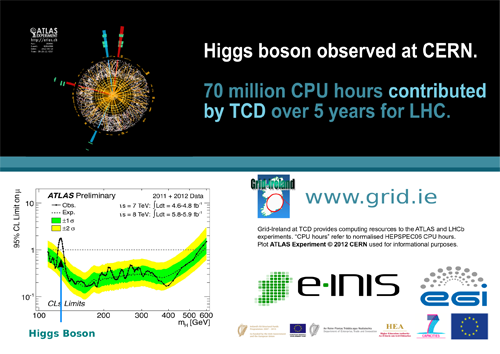Irish Computing Resources Power Search for Higgs Boson
Posted on: 17 July 2012
Researchers in the Computer Architecture and Grid Research group in Trinity College Dublin’s School of Computer Science and Statistics were part of the global effort to analyse the data generated by the Large Hadron Collider experiment and played a key role in the analysis leading to the recent announcement by CERN, the European Organisation for Nuclear Research, of the Higgs Boson.
In order to provide the computing power necessary to store and process this data, hundreds of sites around the world have joined forces to create a giant computing system, known as a “grid”. Scientists can move data around the grid and run programmes on any one of the tens of thousands of computers that are connected. Trinity’s School of Computer Science and Statistics has been involved in the grid since its earliest days.
“Without the worldwide computing, the grid computing, this result would not have been possible,” stated CERN Director General, Rolf Heuer, at the press conference in Geneva where the Higgs Boson discovery was announced.Scientists have been using the Large Hadron Collider (LHC) at CERN, an enormous particle accelerator 27 kilometres in length, to smash together subatomic particles called protons at very high speeds. The collisions produce a host of exotic, short-lived particles, such as the Higgs Boson.
The LHC is capable of generating a billion collisions per second, resulting in huge amounts of data which are analysed on the world-wide computing grid, made up of over 400,000 CPU cores in over 350 sites in over 50 countries around the globe.
The TCD Computer Architecture and Grid Research, led by Dr Brian Coghlan, is involved in this LHC computing effort. This group also manages the Irish computing grid, Grid-Ireland. Trinity has provided almost 20 million CPU hours* to LHC experiments over the past year, and 70 million over the past five years, making their contribution comparable to many larger countries.
*normalised HEPSPEC06 CPU hours

